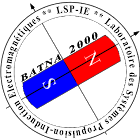, “Adaptive direct power control for double fed induction generator used in wind turbine,” International Journal of Electrical Power & Energy Systems, vol. 114, 2020.Abstract
Publication Internationale
, “Incipient Inter-Turn Short Circuit Fault Estimation Based on a Faulty Model Observer and ANN-Method for Induction Motor Drives,” Recent Advances in Electrical & Electronic Engineering (Formerly Recent Patents on Electrical & Electronic Engineering), vol. 12 N° 4, pp. 374-383, 2019.Abstract
, “Dual Simplex Method for Optimal Coordination of DOCR’s in Distribution System with D-FACTS,” International Journal of Information Science and Technology, vol. 3 N° 3, pp. 3-9, 2019.Abstract
, “Fuzzy –Super twisting control implementation of battery/super capacitor for electric vehicles,” ISA transactions, 2019.Abstract
, “Novel control implementation for electric vehicles based on fuzzy-back stepping approach,” Energy, vol. 178, pp. 644-655, 2019.Abstract
, “Fault-tolerant control of a smart PV-grid hybrid system,” IET Renewable Power Generation, vol. 13 N° 13, pp. 2451-2461, 2019.
, “An Experimental Study on the Smart Home Concept with PV and Energy Management and Control Strategy Using an Open Source Platform,” Distributed Generation & Alternative Energy Journal, vol. 34 N 1, pp. 61-80, 2019.Abstract
, “Comparative study between luenberger observer and extended kalman filter for fault-tolerant control of induction motor drives,” International Information and Engineering Technology Association, vol. 73 N 2, pp. 29-36, 2018.Abstract
, “BLEVE fireball modeling using Fire Dynamics Simulator (FDS) in an Algerian gas industry,” Journal of Loss Prevention in the Process Industries, vol. 54, pp. 69-84, 2018.Abstract
, “A New Implementation of Maximum Power Point Tracking based on Fuzzy Logic Algorithm for Solar Photovoltaic System,” International Journal of Engineering, Transactions A, vol. 31, no. 4, pp. 184-191, 2018.
, “Online robust estimation of flux and load torque in induction motors,” The International Journal of Advanced Manufacturing Technology , vol. 94, no. 5-8, pp. 2703–2713, 2018.
, “Robust Sensorless Vector Control of an Induction Machine Using Multiobjective Adaptive Fuzzy Luenberger Observer,” ISA Transactions, vol. 74, pp. 74, 144-154, 2018.
, “Backstepping glycemic control of type 1 Diabetes for implementation on an embedded system,” The International Journal Bioautomation., vol. 22, no. 2, pp. 117-132, 2018.
, “Sensorless control and diagnosis of synchronous generator used in wind energy conversion system under inter turn short-circuit fault,” International Journal of Power and Energy Conversion, 2018.
